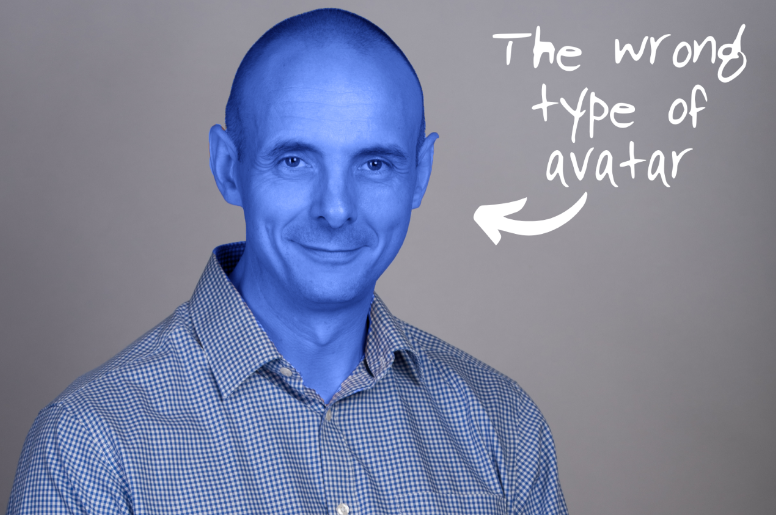Avatars. What the hell are they?
By Mike James | 11th November 2019 | Advice

Sportsinjuryfix.com ambassador and all round clever thinker Dave James is a coach, mentor, speaker and podiatrist. Using coaching and mentoring he works with healthcare business owners to make a health business out of health, advising the video, social media, authenticity and story telling. Dave has kindly shared his thoughts on the concept of avatars.
Let’s talk about avatars.
“I love that film!”, I hear you say.
“CGI, adventure and blue-people!”.
Okay, it is a great film, but that’s not what I am talking about.
I am talking about the kind of avatars that are useful for your clinic, but before I do that, let me tell you a little story.........
When I started my private clinic, I needed one thing... clients.
Why?
Well, to pay the bills, get some cash in and feel successful, and that is cool, because that’s kind of what we all want.
So my marketing was focused on filling the appointments and raising awareness of the practice, because I know what great and amazing work I do and how I can help people.
In the early days I wasn’t really bothered who they were, as long as they had problem feet. Over time more appointments were booked, the gaps between clients decreased and I realised that I needed more skills to treat the wide range of people coming to see me. I trained in as many skills as I possibly could to make sure that I was the expert. It worked - I had a wide range of skills and could treat most people, but there’s a caveat to this. After a while you realise that 80% of those clients are not the ones you want to treat.
I trained in as many skills as I possibly could to make sure that I was the expert. It worked - I had a wide range of skills and could treat most people, but there’s a caveat to this. After a while you realise that 80% of those clients are not the ones you want to treat.
They bring in money to the clinic.
They help to keep a roof over your head.
They let you buy nice things.
But treating them does not bring you sparkle and joy.
For some this may be the point that you think, I’m not enjoying this. You ask yourself, how did I get here?
For some, putting your head down and grinding through is the only option, because the fruits of labour far outweigh the pain. For others, it may lead them to exit the profession.
So what else can you do?
Well, this is where avatars come in.
An avatar is essentially an embodiment of a person or an idea. Its origins are from Hinduism, but the more contemporary use comes in the form of computer games, or the aforementioned film.
In simple terms it’s a way of describing an individual via characteristics otherwise known as demographics. (Okay, so that sounds a bit “science-like”, but bear with me).
Most of you will have come across demographics as part of surveys or questionnaires. The words or terms used to describe features such as gender, race, ethnicity, age, education, profession, etc. All things that can be used to describe individuals (and group them together).
And if you look at the patients you love to treat then you will find a demographic pattern emerging.
Maybe you may love to treat patients of a certain gender, within a certain age group and who have a particular professional status. Maybe these people are more in alignment with your philosophy or you have better outcomes.
Whatever the reason, this is crucial data, because it then helps you to focus more on the patients you love to treat and less on the others. But demographics is only one part of this. There’s another science-like word to add to the mix… Psychographics.
While demographics looks at descriptive features, psychographics delves deeper - interests, hobbies, opinions, values, lifestyle, etc. All the stuff that makes us human and interesting. All the stuff that helps to connect us more with others.
Think about that great friend you have. The one that you started work with many years ago and you could have a tick box because you are in the same industry.
But what is it that has kept you as friends for so long? I’ll bet it’s not that you do the same job or work in the same place, it’s down to the psychographics. The stuff that showed up when you spent time together and got to know one another.
So how do we use this in clinical practice?
People hang around with people that they like (and are like them) so once you know the demographics and the psychographics of the patients you like to treat, you can tailor your business to serve those clients, and your marketing to attract more of them.

Try this exercise:
* Grab a piece of A4 paper and put it down in portrait format (long side up).
* Get your favourite pen and draw a line down the middle.
* On the left write “D” and on the right put “P”.
* Sit and think about a patient that you love to treat. The one that follows your advice, gets better, loves what you do and has a problem that you love to solve.
* Got it? Cool - write their name on the top of the page.
* Now in the D column, write down all the demographic data to describe them - age, gender, occupation, etc.
* And in the P column, write down all the psychographic data to describe them - values, hobbies, interests, etc.
* Sit back and feel smug.
Now you can go as deep as you want with this. Adding as much detail as you can to flesh it out. And when you have this data, you can then use it to focus your marketing to help those patients. You can produce case studies on the people you’ve helped, showcasing the problems they had, how it was solved and how they feel now.
You can talk directly to the people you love to treat, touching on their aspirations, fears and concerns.
You can show how you understand them uniquely and this helps you to stand out in your market place.
Sounds good, right?
When I talk to people about this there is always a little bit of fear and worry that you will be focusing on a group with not enough patients in. And I get that, because it’s a fear we all have.
It’s just not true. The reality is different. Don’t worry, you will still get other patients. The ones that are not ideal for you and your practice, but you can still help them. The benefit of this is that you will have a practice that is more in tune with you, your culture, the way you work and the people you want to help.
A practice that you can love being in.
Give it a go and see how you get on.
You’ll be surprised how good it makes you feel.
To find out more about Dave and how to work with him:
www.davethecoach.co.uk
hello@davethecoach.co.uk
